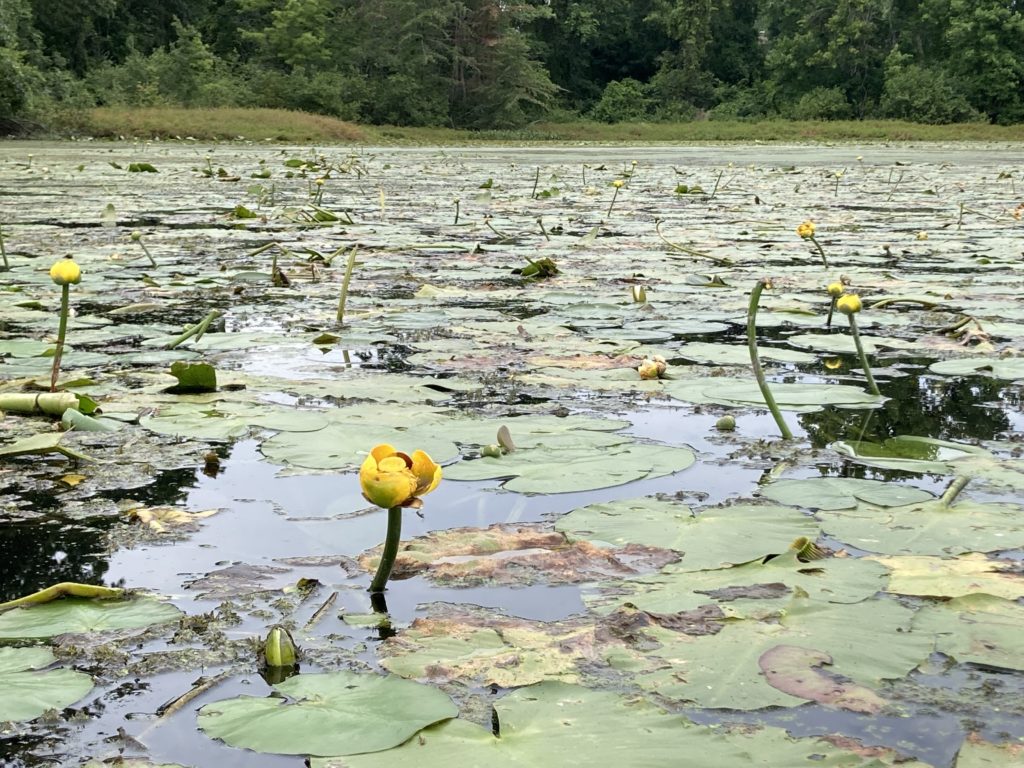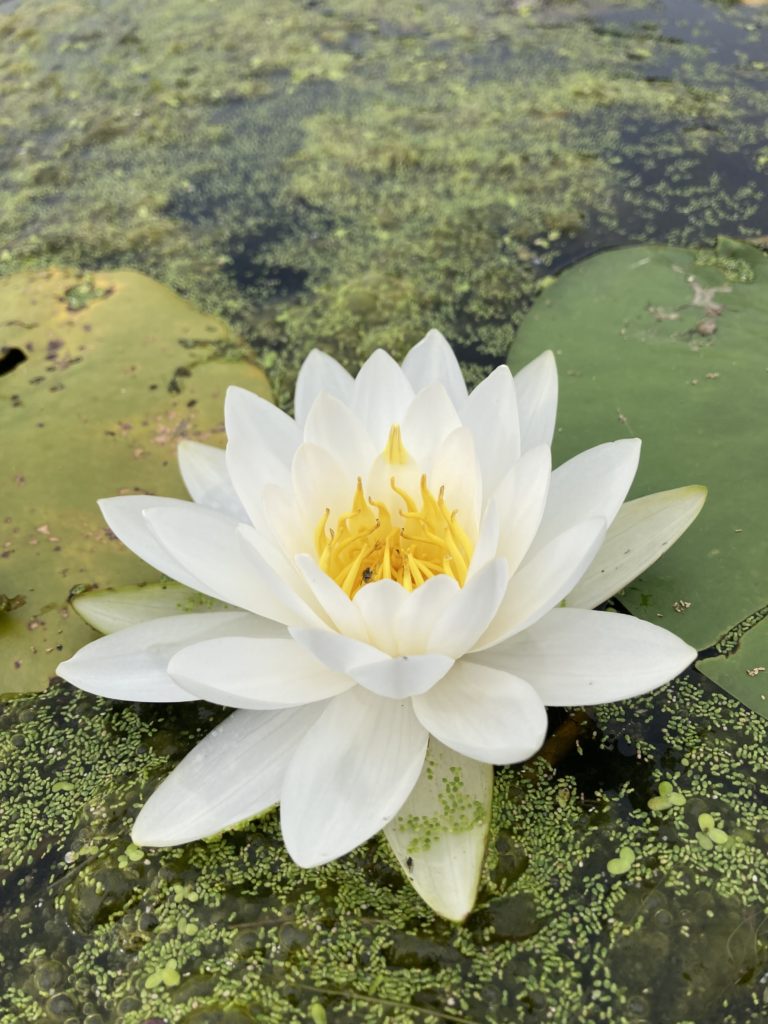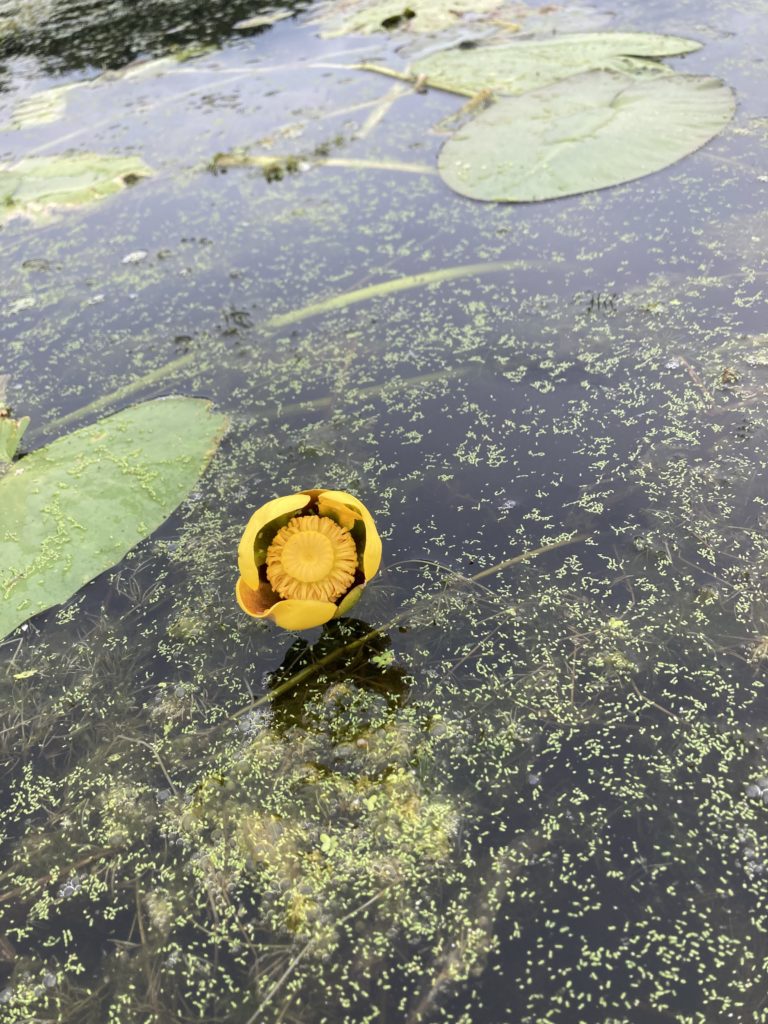Almanac: Lilies Of The Lake

Yellow pond lilies at Lake Warner. Photo: Stephen Braun
The lotus flower blooms most beautifully from the deepest and thickest mud.
Buddha
Paddling Lake Warner in North Hadley at the height of summer often means paddling not on open water but across the broad glistening leaves of the water lilies that cover a great deal of the lake’s surface. It is tempting to seek out the lanes of open water because you don’t need to deal with the dripping lily leaves and clumps of other water plants that cling to the paddle blades with nearly every stroke when crossing the lily mats. But spending some slow time among the lilies offers a host of delights, not least the beautiful flowers of the two native species that make the lake their home: fragrant (white) water lilies and yellow pond lilies (also called spatterdock).

The scientific name for fragrant water lilies is Nymphaea odorata, a nod to the idea that these flowers grace the abodes of water nymphs with their beauty and aroma. It’s worth a paddle just to stick your nose into an open fragrant water lily—their aroma reminds me of a lovely amalgam of gardenia and lilac, but lighter and subtler than either. I’m no fan of perfume, but if somebody managed to bottle that aroma I’d pay good money for it. The flowers themselves are symmetrical beauties with 20-30 white tapering petals, 40 or more bright yellow stamens, and a whorl of four green-to-purplish sepals at the base. The flowers typically open in the morning and close by mid-afternoon, although the other evening I found a few still open around 5:30.
An interesting factoid about fragrant water lilies is that their stomata, the tiny openings through which carbon dioxide and other gases pass into the plant, are on the upper, shiny leaf surface rather than on the lower surface as is the case for most land plants. The leaves also serve as micro-habitats for many creatures including dragonflies and damselflies that use them as resting platforms and hunting grounds. Flip over a lily pad and look closely. You may see a range of tiny creatures and forms including insect larvae, egg masses, beetles, and other invertebrates, some of which live out their entire lives on a single leaf. The other day I found miniature pond snails clinging to the underside of a pad, some so small I could barely make them out. The little fellas slowly graze on algae as they crawl across the underside of the leaves, growing steadily from spring through fall.
The yellow pond lilies are less showy than the fragrant lilies, but they’re beautiful in their own way and serve equally important roles in the ecosystem, as both food and infrastructure for other creatures.

Unlike the fragrant lilies, which always float on the water’s surface, the yellow lilies often extend several inches above the water’s surface, particularly when, as has happened recently, the water level rises for a while, then retreats. The flowers are cup-shaped and consist of six petal-like sepals and many small yellow petals resembling stamens. The large yellowish disk-like stigma at the center of the flower is marked with lines, like the spokes of a wheel.
Both types of water lilies are perennials that emerge each year from thick, starchy rhizomes buried in the muck. You seldom see the rhizomes, but they are dug up and eaten by both muskrats and beavers (both plentiful on the lake). So you’ll sometimes come across these gnarly, alien-looking objects as thick as your forearm and twice as long, floating on the surface or washed up on shore. I’ve read that native Americans ate the rhizomes, boiling or roasting the roots or drying and grinding them into meal. But I’ve also read that large doses of the root are potentially toxic, so I wouldn’t suggest experimenting with rhizomatous cuisine.
As the days shorten and cool on the downside of midsummer, the water lily leaves will turn shades of yellow and red just like maple leaves, and then they’ll die and sink, opening the lake surface again. That will make the paddling easier, but I’ll miss the lilies and will look forward to seeing them again next year.
Almanac is a regular Indy column of observations, musings, and occasional harangues related to the woods, waters, mountains, and skies of the Pioneer Valley. Please feel free to comment on posts and add your own experiences or observations.
